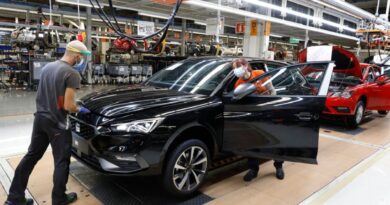Stellantis cut break-even point to less than 50% of capacity in 2021, CEO says
TURIN — Stellantis CEO Carlos Tavares said the automaker was able to reduce its break-even point to less than 50 percent of its installed production capacity in the final months of last year. It did so to protect Stellantis from “chaos” created by the combination of the chip shortage, rising raw materials prices and geopolitical risks.
The auto industry standard break-even point is generally 70 to 80 percent of installed capacity, as measured by the Harbour index, which is based on a plant working two eight-hour shifts for 235 days a year.
Stellantis declined to give a volume figure for the company’s current break-even point or reveal what that number was when the group was created by the merger of PSA Group and Fiat Chrysler Automobiles in January 2021.
Last year, Stellantis shipped 6.14 million units to its distributors and dealers, up 3 percent from 5.95 million in 200 on a pro-forma basis combining the two group’s results.
Its adjusted operating margin jumped by 95 percent to 18 billion euros ($20.4 billion), equivalent to an 11.8 operating margin compared with a 6.9 percent margin in 2020, also on a pro-forma basis.
Tavares told reporters Wednesday that the idea to reduce Stellantis’ break-even point come to mind during his summer break, adding he was proud the company reached this goal by the end of 2021.
“On Sept. 1, I brought the top leadership team to a specific meeting and we decided that we would look to bring the company below 50 percent [of capacity] break-even point,” Tavares said.
His said his view was that there are so many uncertainties around the auto industry that Stellantis needs to think continuously about on how to protect itself from this “chaos.”
Tavares has long considered the break-even point to be a key measure of an automaker’s financial health, a point he reiterated on Wednesday in announcing record earnings at Stellantis.
One of his accomplishments after becoming CEO of PSA in 2014 was to cut the then-struggling group’s break-even point to 1.6 million vehicles in 2017 from 2.6 million in 2013. And after acquiring Opel from GM in 2017, he set the break-even point to 800,000 vehicles from an undisclosed number (at the time, Opel was losing hundreds of millions a year while selling about 1 million vehicles annually).
Tavares said that last year’s tailwinds offset headwinds at Stellantis.
The chip shortage — which led to an imbalance between supply and demand due to production constraints — gave automakers much bettter pricing power. “Which, to make it simple, means less discounting and higher margins,” he said.
On the other hand, he said, an increase in raw materials prices offset much of that higher profitability.
Tavares cited the European market as an advantage of having a lower break-even point. Post-pandemic volume is about 15 millions units, almost 20 percent below the pre-COVID level of 18 million units.
“Given that Stellantis has a share of about 20 percent of the European market, we lost about 600,000 annual sales, even though our market share was unchanged,” he said.
Looking ahead, Tavares said that a return to a normal level of chip supply will increase his profit pool, but potentially at lower margins.
“If there is more chip supply, there will be less imbalance between supply and demand, and therefore less pricing power,” he said. Increased overall profits will cover fixed costs, he added, “but the per-unit margins may be a little bit lower, because we still have raw materials cost inflation.”
Source : Autonews.com




